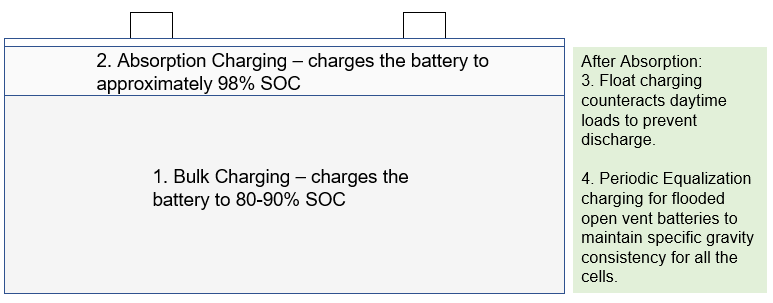Solar charge controllers put batteries through 4 charging stages:
- Bulk
- Absorption
- Float
- Equalize
What are the 4 Solar Battery Charging Stages?
Bulk Charging Voltage
For lead-acid batteries, the initial bulk charging stage delivers the maximum allowable current into the solar battery to bring it up to a state of charge of approximately 80 to 90%. During bulk charging for solar, the battery’s voltage increases to about 14.5 volts for a nominal 12-volt battery.
Absorption Charging
When Bulk Charging is complete and the battery is about 80% to 90% charged, absorption charging is applied. During Absorption Charging, constant-voltage regulation is applied but the current is reduced as the solar batteries approach a full state of charge. This prevents heating and excessive battery gassing. At the end of Absorption Charging, the battery is typically at a 98% state of charge or greater.
Float Charging
Float charging, sometimes referred to as “trickle” charging occurs after Absorption Charging when the battery has about 98% state of charge. Then, the charging current is reduced further so the battery voltage drops down to the Float voltage.
The Float charge of a battery keeps the battery at maximum capacity throughout the day.
Equalization Charging
For flooded open vent batteries, an Equalization charge is applied once every 2 to 4 weeks to maintain consistent specific gravities among individual battery cells. The more deeply a battery is discharged on a daily basis, the more often equalization charging is required. Solar Charge Controller Equalization is for flooded, not for sealed, GEL, or valve-regulated batteries which can be damaged by equalization.
Figure 3: Multi-Stage Battery Charging Diagram

Although lead-acid batteries are the most common type of battery regulated by solar charge controllers, lithium batteries are starting to gain traction. Morningstar launched an Energy Storage Partner program that involves working with many lithium iron phosphate battery manufacturers to maintain the highest state of charge for their batteries and to help maximize battery life.
The integration guides you can download provide custom solar charge controller voltage and time settings for absorption and float charging, and other information that you will need to charge your batteries safely and to increase their longevity. In addition to lead-acid and lithium, Morningstar solar charge controllers can also charge nickel, aqueous hybrid ion, and flow or redox flow batteries.
